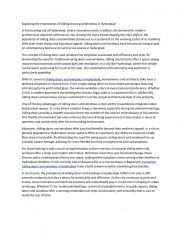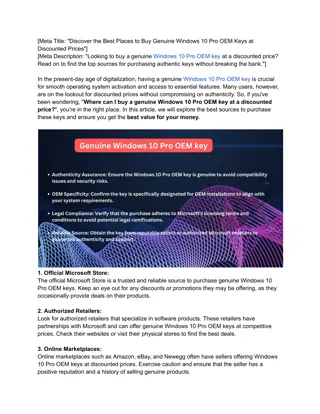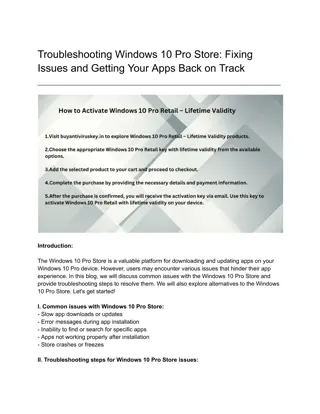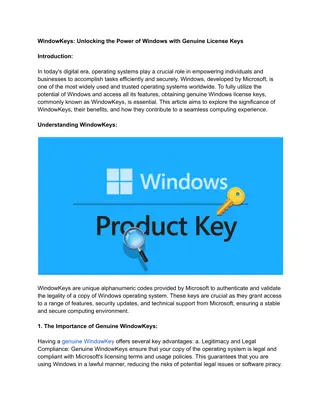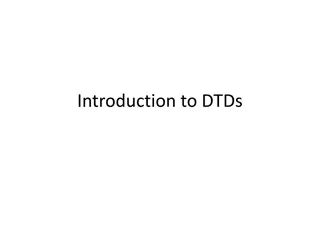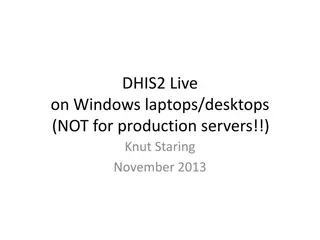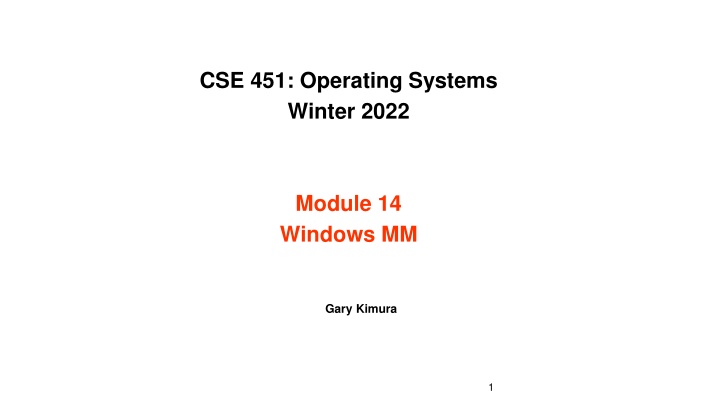
Windows Memory Management Exam Questions and Pool Corruption
Dive into Windows memory management with a focus on page states, paging features, kernel pool, and debugging pool corruption. Explore exam questions from 2013 testing array writing performance and a program allocating and writing to a multi-megabyte array. Discover the intricacies of memory management in Windows Operating Systems.
Download Presentation

Please find below an Image/Link to download the presentation.
The content on the website is provided AS IS for your information and personal use only. It may not be sold, licensed, or shared on other websites without obtaining consent from the author. If you encounter any issues during the download, it is possible that the publisher has removed the file from their server.
You are allowed to download the files provided on this website for personal or commercial use, subject to the condition that they are used lawfully. All files are the property of their respective owners.
The content on the website is provided AS IS for your information and personal use only. It may not be sold, licensed, or shared on other websites without obtaining consent from the author.
E N D
Presentation Transcript
CSE 451: Operating Systems Winter 2022 Module 14 Windows MM Gary Kimura 1
Memory Management (continued) Windows Paging Windows Kernel Heap Wickedly Fun Exam Question
Page States Active (also calledValid) Transition Standby Modified Modified no-write Free Zeroed Rom Bad
Paging Features Local and Globalpage replacement LRU on top of FIFO Hard and Soft pagefaults
Windows Kernel Pool (aka Heap) Boundary tagged Paged and Nonpaged Lookaside lists Node type codes to help quickly identify objects in the pool
Debugging pool corruption Checked build versus Free build Debugging pool corruption bugs, often stale pointers or allocation overruns 0xDEADBEEF and 0xBAADF00D Extra code to check for pool corruption A pointer hack I used to catch a bad actor (data alignment fault)
A Fun Exam Question from 2013 Examine how long it takes a user mode program writing to an array of integers. Assumptions The entire array will fit into physical memory (no paging) The system is pretty much idle except for this program First malloc() the array, and then Time how long it takes to write to every element of the array using various access patterns.
The Actual Exam Question Consider the following program that allocates a multi-megabyte sized array of unsigned longs, and then times how long it takes to write to every array location. The program varies the pattern it uses to write to each array location based on a stride that changes between each pass through the array. For example a stride of 1 makes one pass through the array accessing locations 0,1,2, until the end of the array is reached. A stride of 2 makes two passes through the array, first accessing locations 0,2,4, and then accessing locations 1,3,5, until the end of the array is reached. The program starts with a stride value of 1 and then increases it, based on user input, until the stride is equal to half the size of the array. The program times how long it takes, in seconds, for each new stride through the array. The program takes three parameters, first is the number of megabytes to allocate to the array, the second and third parameters are the multiplication and additive factors used to compute the stride. For example, the parameters 2 1 1 allocate a 2MB array testing stride values of 1,2,3,4, , 131072. Note that 131072 is the halfway point in a 2MB integer array. The parameters 2 2 0 allocate a 2MB array testing stride values of 1,2,4,8,16, ,131072. In other words the stride value doubles each time.
void main (int argc, char *argv[]) { clock_t StartTime, EndTime; unsigned long *Array, Size, StrideTimes, StridePlus, i,j,k; sscanf(argv[1], "%lu", &Size); sscanf(argv[2], "%lu", &StrideTimes); sscanf(argv[4], "%lu", &StridePlus); printf("Size = %luMB\n", Size); // Allocate a test array Size = 1024*1024*Size; if ((Array = malloc(Size)) == NULL) { printf("malloc failed\n"); return; } Size /= 4; // Now test it for strides from 1 to size/2 printf(" Stride Seconds\n"); for (i = 1; i < Size/2; i = (i*StrideTimes)+StridePlus) { printf("%8lu", i); StartTime = clock(); for (j = 0; j < i; j++) { for (k = j; k < Size; k += i) { Array[k] = k; } } EndTime = clock(); printf(", %8.3f\n", ((double)(EndTime - StartTime)/CLOCKS_PER_SEC)); } }
This program was run on both Windows and Linux systems with 4GB of RAM. Here is the data for a run of 1024 2 0 on a Linux system. S i z e =1 0 2 4 M B S t r i d e 512, 1024, 2048, 4096, 8192, 16384, 32768, 65536, 131072, S t r i d e Seconds 1.920 1.560 2.780 5.530 11.450 16.470 15.000 13.390 12.310 Seconds 11.890 12.190 12.960 14.280 16.510 22.070 22.390 21.510 20.270 S t r i d e 262144, 524288, 1048576, 2097152, 4194304, 8388608, 16777216, 33554432, 67108864, Seconds 18.250 14.710 9.810 5.310 4.100 3.820 3.760 2.170 1.170 1, 2, 4, 8, 16, 32, 64, 128, 256,
Two questions to answer [20 points] Notice how the first pass with a stride of 1 takes longer then the second pass with a stride of 2. This behavior showed up consistently on Linux but not Windows. Please give a plausible explanation for what causes this phenomenon (it might be a mix of both hardware and software), and what the operating system can do to prevent it. You will need to justify your answer. [20 points] Also notice how the time for each pass increases and then decreases as the stride values grow from 1 to 67108864. Both Windows and Linux exhibited this behavior. Please give a plausible explanation for this phenomenon (it might be a mix of both hardware and software), and what the operating system can do to prevent it. You will need to justify your answer.
Things to consider Zero pages TLB behavior Various cache levels Cache line sizes
Now consider the same program run with 64 1 1. The entire output is too long to include here, but the following is a small section of the output that shows another anomaly that occurs on both Windows and Linux. S i z e = 6 4M B Seconds 0 . 1 09 0 . 1 09 0 . 1 09 0 . 1 09 0 . 1 09 0 . 0 93 0 . 1 09 0 . 1 09 0 . 1 09 0.109 0 . 1 40 0 . 0 93 0 . 1 24 0 . 0 93 0 . 1 09 0 . 2 49 0 . 1 09 0 . 1 09 0 . 1 09 0 . 1 71 0 . 1 09 0 . 1 09 0 . 1 09 0 . 4 05 0 . 1 09 0 . 0 93 S t r id e Seconds 0.109 0.140 0.093 0.109 0 . 5 30 0.109 0.093 0.109 0.109 0.109 0.109 0.109 0.109 0.109 0 . 2 02 0.109 0.093 0.109 0.109 0.093 0.171 0.093 0.109 0.109 0.093 0.109 S t r id e Seconds 0.124 0.109 0.109 0.093 0.109 0.109 0.109 0.109 0.109 0.109 0.109 0.109 0.093 0 . 4 99 0.109 0 . 1 09 0 . 7 48 0.109 0.093 0.124 0.093 0.109 0.109 0.109 0.124 0.093 Stride 700, 701, 702, 703, 7 0 4 , 705, 706, 707, 708, 709, 710, 711, 712, 713, 7 1 4 , 715, 716, 717, 718, 719, 720, 721, 722, 723, 724, 725, 726, 727, 728, 729, 730, 731, 732, 733, 734, 735, 736, 737, 738, 739, 740, 7 4 1 , 7 4 2 , 743, 744, 745, 746, 747, 748, 7 4 9 , 750, 751, 752, 753, 754, 755, 756, 757, 758, 759, 760, 761, 762, 763, 764, 7 6 5 , 766, 7 6 7 , 7 6 8 , 769, 770, 771, 772, 773, 774, 775, 776, 777,
Question to ponder [20 points] Notice how the times are consistently in the low 100ms range except for an occasional blip in the 200ms to 700ms range. These blips have been underlined. Please offer an explanation for these blips. Your answer needs to offer a plausible explanation of what is causing this anomaly (it might be a mix of both hardware and software), and what the operating system can do to prevent it, if anything. You will need to justify your answer. If you do cannot offer an educated guess on what causes this phenomenon explain what you could do to determine its cause.
Things to consider Virtual and physical caches Page coloring Side channel attacks
An observation Caches work great, except when they don t

